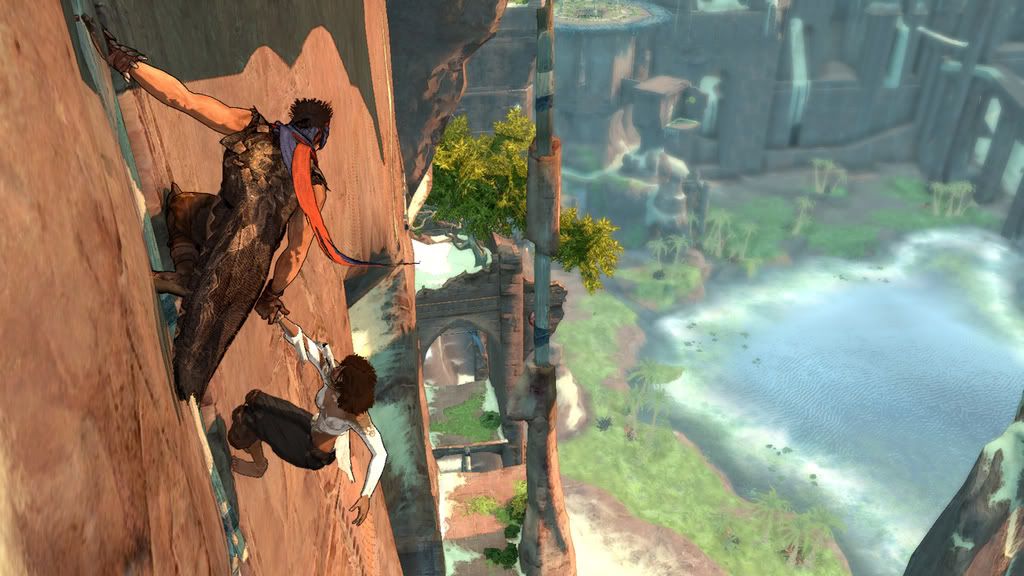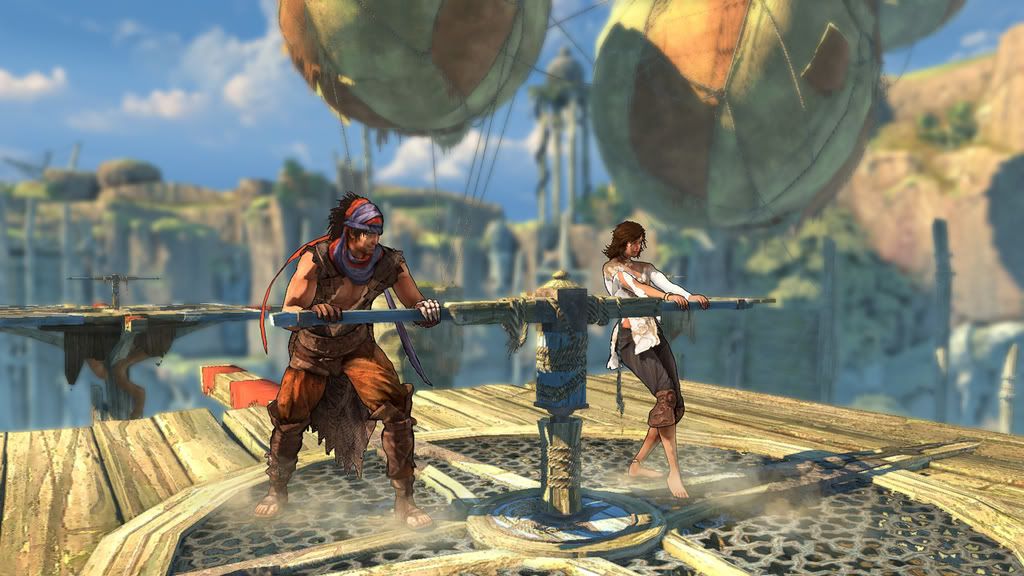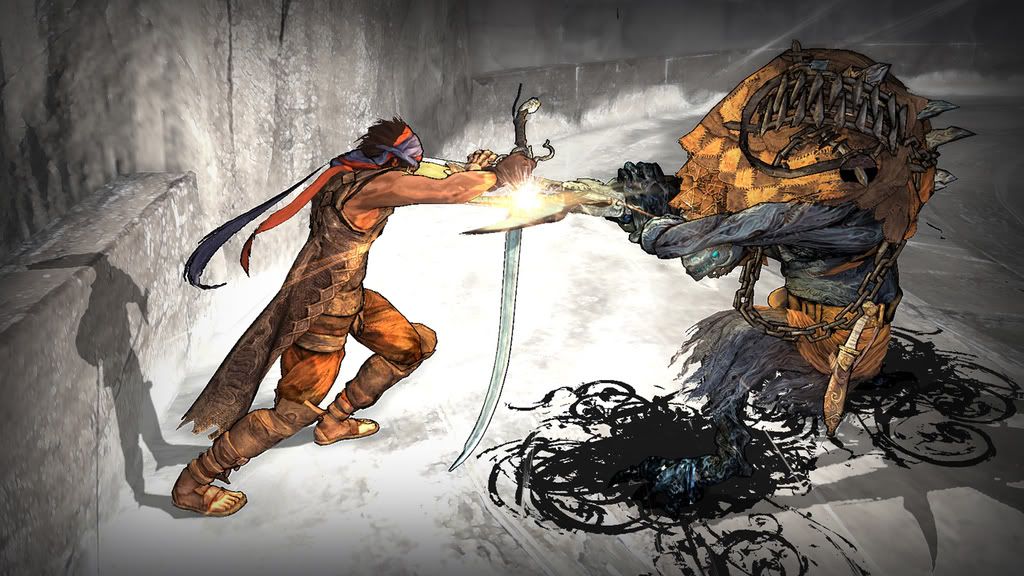 What's this? A relevant review?! Anyways, Ubisoft has re-reinvented the classic Prince of Persia franchise for the new generation. Does it leap forward or does it take a step back?
What's this? A relevant review?! Anyways, Ubisoft has re-reinvented the classic Prince of Persia franchise for the new generation. Does it leap forward or does it take a step back?Funny thing about that last sentence. The only other Prince of Persia game I've ever played is the original one on NES, so I can't even compare this game to the Sands of Time trilogy. In fact, the closest game I could compare this to is Shadow of the Colossus and/or ICO, as both games feature vast open lands, a companion, and 1:1 battles. Not that it's a bad thing, since both of those Team ICO titles are pure works of art, but the real question is: Does Ubisoft create a new PoP that is accessible to even a gamer that hasn't played a previous game in the franchise.
 Story
StoryTo start a-new in the current generation of gaming, Ubisoft decided to re-revamp this franchise from the Sands of Time trilogy of the last generation. That means a new Prince, a new setting, and a new world entirely. The game starts out with our unnamed hero traversing through the desert after losing his donkey; he stumbles upon a girl, Elika, being chased by some guards and quickly steps in to save her. He soon finds out that he's entered into something much bigger than himself, and now must stop the dark lord Ahriman from corrupting the land. The game explains it much better than I ever will, but in short: The land is corrupted, and you and Elika are the only ones that can stop it. It's not the greatest of tales, but it will give you some reason to keep playing.
Gameplay
What can't I say about this? Unlike most people picking this title up, as stated before, I haven't played the previous Prince of Persia games, so there was no adjusting from an old style for me. I was able to pick up this game like any other "new" game and get into the action right away with simple on screen prompts saying what to do. Sure, those of you thinking you're too good for tutorials will complain, as there's no difficulty settings, but I think the game works well as is.
 The entire game is set upon one large map, and the only time you'll encounter a load screen is when you enter the Temple, an area only entered five or so times within the game. Otherwise you can think of the game as Shadow of the Colossus, in that you have your big map, and Elika, who can be used to point your way (think of the light beam reflecting off the sword) after you have selected your destination. The pointer system works well, especially when you encounter a fork in your path or can't spot the ledge you need jump off of. It may seem a bit "noobish" but unlike Zelda's Navi, this is all accessed voluntarily, so if you don't want a hint, don't press the button.
The entire game is set upon one large map, and the only time you'll encounter a load screen is when you enter the Temple, an area only entered five or so times within the game. Otherwise you can think of the game as Shadow of the Colossus, in that you have your big map, and Elika, who can be used to point your way (think of the light beam reflecting off the sword) after you have selected your destination. The pointer system works well, especially when you encounter a fork in your path or can't spot the ledge you need jump off of. It may seem a bit "noobish" but unlike Zelda's Navi, this is all accessed voluntarily, so if you don't want a hint, don't press the button.The game overall takes on a minimalistic approach to platforming. There are no NPCs or rounds of enemies, it's just the Prince, Elika, and the land. Of course that's not all, as you'll have to square off against Soldiers of Ahriman in 1 on 1 battles, actually 2 on 1 if you include Elika; as well as boss battles between four main antagonists, of whom you will face multiple times. Platforming wise, the game is quite simple, you can run along the walls, climb on vines and swing from poles, the usual. But with the aid of the Prince's gauntlet, you can now scale down cliffs by digging your mitt into them, and even climb while upside down; both admittedly cool techniques when seen in motion. There are more techniques used by accessing special plates, but it'd be somewhat of a spoiler for me to tell you about those.
 The main thing players will notice is the lack of death. Falling down a cliff, or falling to a boss will not detract your life meter or make you lose a life, nothing like that. Instead you'll see a quick scene of Elika grabbing your hand and you'll return to the last surface you stood upon. In battle, falling to a foe will just let you get back up while the enemy regains a bit of health. Some will say this detracts from the difficulty of the game, but personally it made the game more enjoyable because I knew I wouldn't have to replay an entire level if I didn't make a jump or fight a boss all over again just because I couldn't find a weak point.
The main thing players will notice is the lack of death. Falling down a cliff, or falling to a boss will not detract your life meter or make you lose a life, nothing like that. Instead you'll see a quick scene of Elika grabbing your hand and you'll return to the last surface you stood upon. In battle, falling to a foe will just let you get back up while the enemy regains a bit of health. Some will say this detracts from the difficulty of the game, but personally it made the game more enjoyable because I knew I wouldn't have to replay an entire level if I didn't make a jump or fight a boss all over again just because I couldn't find a weak point. As for the levels, each will start out in a "Corrupted" state, requiring you to access the Fertile Grounds and heal the land. Corrupted areas will have anywhere from black and white, to dirty green appearance, and will be littered with black "corruption" that will be ready to swallow you in. However, when healed, the newly lush area will be filled with 'Light Seeds', little orbs required to access the next set of areas. The levels may feel a bit linear to some, as there are no two ways to get to a specific point, however the order in which you play levels is entirely up to the player, so its nonlinear in that sense.
As for the levels, each will start out in a "Corrupted" state, requiring you to access the Fertile Grounds and heal the land. Corrupted areas will have anywhere from black and white, to dirty green appearance, and will be littered with black "corruption" that will be ready to swallow you in. However, when healed, the newly lush area will be filled with 'Light Seeds', little orbs required to access the next set of areas. The levels may feel a bit linear to some, as there are no two ways to get to a specific point, however the order in which you play levels is entirely up to the player, so its nonlinear in that sense.One fault, if you see it that way, is that the gameplay never changes. There's no new weapons to acquire, nor new moves to learn. How you fight in your first battle will be the way you fight your last. It worked for me, as I was able to get comfortable with certain combos and techniques without worrying about how to change that up with the introduction of a new weapon. But that system just won't be for everyone, especially those too stuck in the mode of the previous games.
 Graphics
GraphicsThis game is a graphics masterpiece. Not so much for a power to produce realism, but just for the fact that this game reeks of style. It's a mix of cel-shaded characters and props, with a stylized, but vast environment. Corrupted areas will have their washed out, gross appearance, and yet they're still as striking as the rest of the game. In fact, once healed, the game utilizes something almost unheard of in this generation of games, COLOR. The first time you heal a land you will be reminded of lifting Orochi's curse in Okami or ridding Hyrule of twilight in The Legend of Zelda: Twilight Princess; it's gorgeous, especially when seen in full high-definition. If Wind Waker and/or Okami were the epitomes of cel-shading last generation, then Prince of Persia has set a new benchmark.
Sound
The soundtrack fits the game. That's really all there is to it, it's not a game you'll be humming to yourself during the day, but it works. Also, not sure if this effects all versions of the game, or maybe it's just my PS3, but a few times I found the game would sometimes go silent for a few seconds before the music came back. As for the voice over, I found each character's voice to be fitting of who they are. Not everyone's going to like the Prince's (Nolan North) comedic personality and tone, as I'll agree, there are parts where it's just unnecessary, but it does make him stand out from the other characters of the game.
 Final Thoughts
Final ThoughtsFor the first modern Prince of Persia game that I've played, I will say, this game makes me want more. The game only takes about 12 hours to beat, but the addition of Trophies adds some replayability, even if a bulk of them are easily unlocked. Personally, it was the visual style that actually attracted me to this title, the fact that it played well was just an added bonus. And with the lack of platformers this generation, it's nice to know someone can create create something new and unique, even if it does have the familar taste of Shadow of the Colossus or Okami in it. So if you want something visually brilliant, colorful, and lacking in the guns and meat men department, this game is for you. As for fans of the series, all I ask of you is to be accepting of the series' new direction, as a squeal is inevitable, and I hope they stick to the style of this game.
Overall Score: 9.4/10


























No comments:
Post a Comment